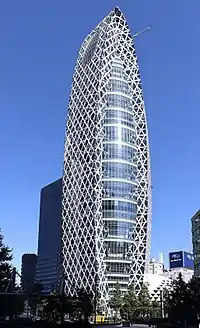Mode Gakuen Cocoon Tower
Mode Gakuen Cocoon Tower (モード学園コクーンタワー, Mōdo gakuen kokūn tawā) is a 204 metres (669 feet), 50-story educational facility located in the Nishi-Shinjuku district in Shinjuku, Tokyo, Japan. The building is home to three educational institutions: Tokyo Mode Gakuen (fashion vocational school), HAL Tokyo (special technology and design college), and Shuto Ikō (medical college). Completed in October 2008, the tower is the second-tallest educational building in the world and is the 17th-tallest building in Tokyo. It was awarded the 2008 Skyscraper of the Year by Emporis.
| Mode Gakuen Cocoon Tower | |
|---|---|
モード学園コクーンタワー | |
 | |

| |
| General information | |
| Type | Educational institution |
| Architectural style | Structural expressionism |
| Location | 1-7-3 Nishi-Shinjuku Shinjuku, Tokyo, Japan |
| Coordinates | 35°41′30″N 139°41′49″E |
| Construction started | 2006 |
| Completed | 2008 |
| Opening | October 2008 |
| Height | |
| Roof | 204 meters (669 ft) |
| Technical details | |
| Floor count | 50 above ground 3 below ground |
| Design and construction | |
| Architect | Tange Associates |
| Structural engineer | Arup |
| Main contractor | Shimizu Corporation |
Design
Mode Gakuen invited architects to compete to build its new Tokyo location, stipulating that the building could not be rectangular. About 50 architects submitted more than 150 proposals. The winner had a curved shell of white aluminum and dark blue glass, criss-crossed by a web of white diagonal lines. The architects, Tange Associates, said its cocoon-like shape symbolizes nurturing the students inside;[1] they also said they wanted the building to revitalize the surrounding area and to create a gateway between Shinjuku Station and the Shinjuku central business district.[2] The building earned the firm the Emporis 2008 Skyscraper of the year award.[3]
Facilities
Built on the former site of the now-demolished Asahi Life headquarters, construction of the Mode Gakuen Cocoon Tower began in May 2006 and was completed in October 2008.[4][2] The 204 metres (669 feet)-tall, 50-story tower is the second-tallest educational building in the world (surpassed only by the main building of the Moscow State University) and is the 17th-tallest building in Tokyo.[4] The vertical campus can accommodate 10,000 students for the three vocational schools that occupy the building. Tokyo Mode Gakuen, for which the building in named after, is a fashion school. The other schools, HAL Tokyo and Shuto Ikō, are information technology and medical schools, respectively, that are operated by Mode Gakuen University. Each floor of the tower contains three rectangular classrooms that surround an inner core. The inner core consists of an elevator, a staircase and a support shaft. Every three floors, a three-story student lounge is located between the classrooms and faces three directions: east, southwest and northwest.[2]
 Inside the tower, 2016
Inside the tower, 2016 Detail of side, 2016
Detail of side, 2016 Tower at night, 2019
Tower at night, 2019
See also
References
- Takano, Kiyomi (January 14, 2009). "Unusual structures grab attention". The Daily Yomiuri. Archived from the original on April 1, 2020. Retrieved January 29, 2009.
- Young, Niki May (January 23, 2009). "Recently completed Cocoon Tower makes education design as easy as A-B-C". WorldArchitectureNews.com. Archived from the original on October 7, 2014. Retrieved January 26, 2009.
- "Tokyo's Cocoon Tower selected as 2008 Skyscraper of the Year". Europe Real Estate. January 22, 2009. Retrieved January 26, 2009.
- "Mode Gakuen Cocoon Tower". Emporis.com. Retrieved January 26, 2009.
External links
 Media related to Mode Gakuen Cocoon Tower at Wikimedia Commons
Media related to Mode Gakuen Cocoon Tower at Wikimedia Commons